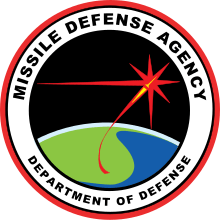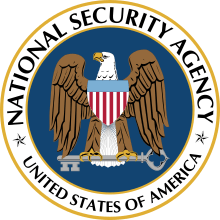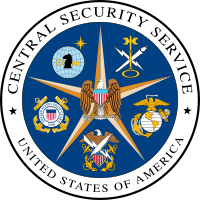Organizational structure of the United States Department of Defense

The United States Department of Defense (DoD) has a complex organizational structure. It includes the Army, Navy (the Marine Corps is a subset of the Navy), Air Force, the Unified combatant commands, U.S. elements of multinational commands (such as NATO and NORAD), as well as non-combat agencies such as the Defense Intelligence Agency and the National Security Agency. The DoD's annual budget was roughly US$496.1 billion in 2015.[1] This figure is the base amount and does not include the $64.3 billion spent on "War/Non-War Supplementals". Including those items brings the total to $560.4 billion for 2015.[1]
Civilian control over matters other than operations is exercised through the three service departments, the Department of the Army, the Department of the Navy (which includes the Marine Corps), and the Department of the Air Force. Each is led by a service secretary, who is below Cabinet rank.
In wartime, the Department has authority over the Coast Guard, which is under the control of the Department of Homeland Security (DHS) in peacetime. Prior to the creation of DHS, the Coast Guard was under the control of the Department of Transportation, and earlier under the Department of the Treasury. According to the U.S. Code, the Coast Guard is at all times considered one of the five armed services of the United States. During times of declared war (or by Congressional direction), the Coast Guard operates as a part of the Navy; this has not happened since World War II, but members have served in undeclared wars and conflicts since then while the service remained in its peacetime department.
The Pentagon, in Arlington County, Virginia, across the Potomac River from Washington, D.C., is the Department's headquarters. The Department is protected by the Pentagon Force Protection Agency, which ensures law enforcement and security for the Pentagon and various other jurisdictions throughout the National Capital Region (NCR).
Chain of Command
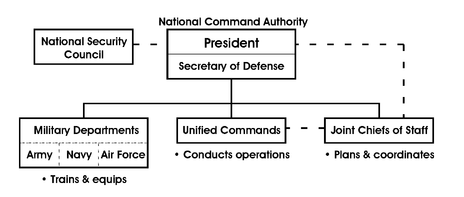
The President of the United States is, according to the Constitution, the Commander-in-Chief of the U.S. Armed Forces and Chief Executive of the Federal Government. The Secretary of Defense is the "Principal Assistant to the President in all matters relating to the Department of Defense", and is vested with statutory authority (10 U.S.C. § 113) to lead the Department and all of its component agencies, including military command authority second only to the President.
The President and the Secretary of Defense exercise authority and control of the Armed Forces through two distinct branches of the chain of command. One branch (10 U.S.C. § 162) runs from the President, through the Secretary of Defense, to the Combatant Commanders for missions and forces assigned to their commands. The other branch, used for purposes other than operational direction of forces assigned to the combatant commands, runs from the President through the Secretary of Defense to the Secretaries of the Military Departments, i.e., the Secretary of the Army (10 U.S.C. § 3013), the Secretary of the Navy (10 U.S.C. § 5013), and the Secretary of the Air Force (10 U.S.C. § 8013). The Military Departments, organized separately within the Department, operate under the authority, direction, and control of the Secretary of that Military Department. The Secretaries of the Military Departments exercise authority through their respective Service Chiefs (i.e., Chief of Staff of the Army, Commandant of the Marine Corps, Chief of Naval Operations, and Chief of Staff of the Air Force) over forces not assigned to a Combatant Command. The Service Chiefs, except as otherwise prescribed by law, perform their duties under the authority, direction, and control of the Secretaries of their respective Military Departments, to whom they are directly responsible.
In the Goldwater-Nichols Department of Defense Reorganization Act of 1986, Congress clarified the command line to the combatant commanders and preserved civilian control of the military. The Act states that the operational chain of command runs from the President to the Secretary of Defense to the Combatant Commanders. The Act permits the President to direct that communications pass through the Chairman of the Joint Chiefs of Staff from the Secretary of Defense, and to the Combatant Commanders. This authority places the Chairman in the communications chain. Further, the Act gives the Secretary of Defense wide latitude to assign the Chairman oversight responsibilities for the activities of the Combatant Commanders.
Civilian control
Article II Section 2 of the Constitution designates the President as "Commander in Chief" of the Army, Navy and state militias.[2] The President exercises this supreme command authority through the civilian Secretary of Defense, who by federal law is the head of the department, has authority direction, and control over the Department of Defense, and is the principal assistant to the President in all matters relating to the Department of Defense.[3] The Secretary's principal deputy is the equally civilian Deputy Secretary of Defense who is delegated full powers to act for the Secretary of Defense. The Office of the Secretary of Defense (OSD) is the Secretary and Deputy Secretary's civilian staff, which includes several Under Secretaries and Assistant Secretaries of Defense with functional oversight responsibilities. The Secretaries of the Military Departments (i.e. Secretary of the Army, Secretary of the Navy, and Secretary of the Air Force) are subordinate to the Secretary of Defense. They have the authority under Title 10 of the United States Code to conduct all the affairs of their respective departments (Department of the Army, Department of the Navy, and Department of the Air Force) within which the military services are organized.[4]
Historically, there have been challenges to civilian control. Most notably, during the Korean War, General Douglas MacArthur ignored civilian instructions regarding advancing troops toward the Yalu River, which triggered an introduction of massive forces from China. Also, on April 5, 1950, Representative Joseph William Martin, Jr., the Minority Leader of the United States House of Representatives, released copies of a letter from MacArthur critical of President Harry S. Truman's limited-war strategy to the press and read it aloud on the floor of the house.[5] President Truman relieved MacArthur of command, and MacArthur then explored political options against Truman.[6] The Revolt of the Admirals is another example in the same era of a challenge to civilian control.
DoD policies and directives protect the policy of civilian control by establishing strict limitations on the political activities of members of the military. For example, DoD Directive 1344.10 prohibits active-duty members of the military from running for office or making political appearances in uniform.[7] However, enforcing this strict separation between the military and politics has been problematic. For example, over the years, many elected officials, including members of Congress, continued serving in the reserves while holding elected office. As another example, at a September 14, 2007, rally for Republican Presidential candidate John McCain in New Hampshire, seven on-duty uniformed Army personnel addressed the gathering.[8] As another example, although DOD Directive 1344.10 prohibits political appearances by active-duty military members in uniform, Virginia Governor Bob McDonnell invited a uniformed Army Staff Sergeant to stand behind him during his televised Republican response to the 2010 State of the Union Address.[9][10]
Components of the Department of Defense
| Program | |
|---|---|
| Secretary of Defense | Deputy Secretary of Defense |
| Chief Management Officer of the Department of Defense | |
| Acquisition and Sustainment Under Secretary of Defense for Acquisition and Sustainment Operational Test and Evaluation Directorate |
Assistant Secretary of Defense (Acquisition) *Deputy Assistant Secretary of Defense (Manufacturing and Industrial Base Policy) *Deputy Assistant Secretary of Defense (Policy, Planning, Resources, and Performance) *Deputy Assistant Secretary of Defense (Warfare Systems Support) *Deputy Assistant Secretary of Defense (Defense Procurement) *Defense Acquisition University |
| Assistant Secretary of Defense (Sustainment) *Deputy Assistant Secretary of Defense (Material Readiness) *Deputy Assistant Secretary of Defense (Program Support and Logistics Policy) *Deputy Assistant Secretary of Defense (Transportation Policy) | |
| Assistant Secretary of Defense (Nuclear, Chemical & Biological Defense Programs) *Deputy Assistant Secretary of Defense (Nuclear Matters) *Deputy Assistant Secretary of Defense (Chemical and Biological Defense Policy) *Deputy Assistant Secretary of Defense (Threat Reduction and Arms Control) | |
| Defense Logistics Agency | |
| Defense Contract Management Agency | |
| Defense Threat Reduction Agency | |
| Research and Engineering Under Secretary of Defense for Research and Engineering |
Deputy Under Secretary of Defense (Research and Engineering) |
| Assistant Secretary of Defense (Research and Technology) *Deputy Assistant Secretary of Defense (Research and Technology Investment) *Deputy Assistant Secretary of Defense (Laboratories and Personnel) | |
| Assistant Secretary of Defense (Advanced Capabilities) *Deputy Assistant Secretary of Defense (Mission Engineering and Integration) *Deputy Assistant Secretary of Defense (Prototyping and Experimentation) *Defense Technical Information Center *Test Resource Management Center | |
| Defense Science Board | |
| Strategic Intelligence Analysis Cell | |
| Missile Defense Agency | |
| Defense Advanced Research Projects Agency (DARPA) | |
| Strategic Capabilities Office | |
| Defense Innovation Unit-Experimental | |
| Policy Under Secretary of Defense for Policy |
Assistant Secretary of Defense (Strategy, Plans, and Capabilities) *Deputy Assistant Secretary of Defense (Strategy and Force Development) *Deputy Assistant Secretary of Defense (Plans) *Deputy Assistant Secretary of Defense (Nuclear and Missile Defense Policy) *Deputy Assistant Secretary of Defense (Security Cooperation) |
| Assistant Secretary of Defense (International Security Affairs) *Deputy Assistant Secretary of Defense (African Affairs) *Deputy Assistant Secretary of Defense (Middle East) *Deputy Assistant Secretary of Defense (Europe and NATO) *Deputy Assistant Secretary of Defense (Russia, Ukraine, and Eurasia) *Secretary of Defense Representative in the United States Mission to NATO *Secretary of Defense Representative to the Organization for Security and Co-operation in Europe | |
| Assistant Secretary of Defense (Homeland Defense) and Global Strategic Affairs *Deputy Assistant Secretary of Defense (Cyber Policy) *Deputy Assistant Secretary of Defense (Space Policy) *Deputy Assistant Secretary of Defense (Countering Weapons of Mass Destruction) *Deputy Assistant Secretary of Homeland Defense Integration and Defense Support of Civil Authorities *Deputy Assistant Secretary of Defense (Defense Continuity and Mission Assurance) | |
| Assistant Secretary of Defense (Special Operations and Low-Intensity Conflict) *Deputy Assistant Secretary of Defense (Counternarcotics and Global Threats) *Deputy Assistant Secretary of Defense (Stability and Humanitarian Affairs) *Deputy Assistant Secretary of Defense (Special Operations and Combatting Terrorism) | |
| Assistant Secretary of Defense (Asian and Pacific Security Affairs) *Deputy Assistant Secretary of Defense (East Asia) *Deputy Assistant Secretary of Defense (South and Southeast Asia) *Deputy Assistant Secretary of Defense (Afghanistan, Pakistan, and Central Asia) | |
| Defense POW/MIA Accounting Agency | |
| Defense Security Cooperation Agency | |
| Defense Policy Board Advisory Committee | |
| Defense Prisoner of War/Missing Personnel Office | |
| Defense Technology Security Administration | |
| Comptroller Under Secretary of Defense (Comptroller) |
Principal Deputy Under Secretary of Defense (Comptroller) |
| Defense Contract Audit Agency | |
| Defense Finance and Accounting Service | |
| Personnel and Readiness Under Secretary of Defense for Personnel and Readiness |
Principal Deputy Under Secretary of Defense (Personnel and Readiness) *Joint Advertising Marketing Research & Studies (JAMRS)[11] |
| Military Deputy to the Under Secretary of Defense (Personnel and Readiness) *Office of Diversity Management and Equal Opportunity **Defense Equal Opportunity Management Institute *Defense Suicide Prevention Office *Personnel Risk Reduction Office | |
| Assistant Secretary of Defense (Health Affairs) *Military Health System[12] **TRICARE Management Activity[13] *Deputy Assistant Secretary of Defense (Wounded Warrior Care & Transition Policy) | |
| Assistant Secretary of Defense (Manpower and Reserve Affairs) *Defense Commissary Agency *Department of Defense Education Activity **Department of Defense Dependents Schools *Deputy Assistant Secretary of Defense (Civilian Personnel Policy) *Deputy Assistant Secretary of Defense (Military Personnel Policy) *Deputy Assistant Secretary of Defense (Military Community and Family Policy) *Deputy Assistant Secretary of Defense (Readiness) *Office of Total Force Planning & Requirements *Transition to Veterans Program Office | |
| Defense Human Resources Activity | |
| DoD/VA Collaboration Office | |
| Uniformed Services University of the Health Sciences | |
| Office of the Chancellor for Education and Professional Development | |
| Intelligence Under Secretary of Defense for Intelligence |
Principal Deputy Under Secretary of Defense (Intelligence) |
| Assistant Secretary of Defense for Networks and Information Integration *Defense Information Systems Agency | |
| Director for Defense Intelligence (Warfighter Support) | |
| Director for Defense Intelligence (Intelligence & Security) | |
| Director for Defense Intelligence (Technical Collection & Special Programs) | |
| Director for Defense Intelligence (Intelligence Strategy, Programs & Resources) | |
| Defense Security Service | |
| Defense Intelligence Agency | |
| National Geospatial-Intelligence Agency | |
| National Security Agency | |
| Central Security Service | |
| National Reconnaissance Office | |
| Other | Assistant Secretary of Defense (Public Affairs) *Deputy Assistant Secretary of Defense (Internal Communications) *Defense Media Activity |
| Director of Administration and Management *Pentagon Force Protection Agency *Washington Headquarters Services | |
| Director of Cost Assessment and Program Evaluation *Office of Net Assessment | |
| General Counsel of Defense *Defense Legal Services Agency | |
Defense Agencies
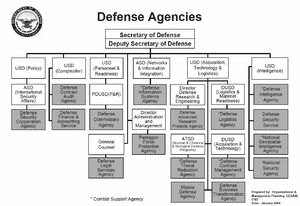
Defense Agencies are established as DoD Components by law, the President, or the Secretary of Defense to provide for the performance, on a DoD-wide basis, of a supply or service activity that is common to more than one Military Department when it is determined to be more effective, economical, or efficient to do so, pursuant to sections 101, 191(a), and 192 of Title 10 of the United States Code or when a responsibility or function is more appropriately assigned to a Defense Agency. Pursuant to section 191(b) Title 10, such organizations are designated as Defense Agencies. Each Defense Agency operates under the authority, direction, and control of the Secretary of Defense, through a Principal Staff Assistant in the Office of the Secretary of Defense.
Department of Defense Field Activities
Department of Defense Field Activities are established as DoD Components by law, the President, or the Secretary of Defense to provide for the performance, on a DoD-wide basis, of a supply or service activity that is common to more than one Military Department when it is determined to be more effective, economical, or efficient to do so, pursuant to sections 101, 191(a), and 192 of Title 10 of the United States Code. Pursuant to section 191(b) of Title 10, such organizations are designated as DoD Field Activities. Each DoD Field Activity operates under the authority, direction, and control of the Secretary of Defense, through a Principal Staff Assistant in the Office of the Secretary of Defense.
Military Departments
Department of the Army
The Department of the Army includes all elements of the U.S. Army
Headquarters, Department of the Army
Army Field Organizations
- Army Commands
- Army Component Commands
- Field Operating Agencies
- Direct Reporting Units
Department of the Navy
The Department of the Navy includes all elements of the U.S. Navy and the U.S. Marine Corps
Navy Department
Department of the Air Force
The Department of the Air Force includes all elements of the U.S. Air Force
Headquarters Air Force
Air Force Field Organizations
Organization of the Joint Chiefs of Staff
- Chairman of the Joint Chiefs of Staff
- Vice Chairman of the Joint Chiefs of Staff
- Joint Chiefs of Staff
- The Joint Staff
- Director of the Joint Staff
- DOM- Directorate of Management
- J1 - Personnel and Manpower
- J2 - Intelligence
- J3 - Operations
- J4 - Logistics
- J5 - Strategic Plans and Policy
- J6 - Command, Control, Communications and Computer Systems
- J7 - Operational Plans and Joint Force Development
- J8 - Force Structure, Resources, and Assessment
- Director of the Joint Staff
- National Defense University
- College of International Security Affairs
- Industrial College of the Armed Forces
- Information Resources Management College
- Joint Forces Staff College
- National War College
- U.S. Delegation to the Inter-American Defense Board
- U.S. Delegation to the United Nations Military Staff Committee
- U.S. Representative at the NATO Military Committee
- U.S. Section, Joint Mexico-U.S. Defense Commission
Unified Combatant Commands
There are ten Unified Combatant Commands; six regional and four functional. Africa Command became initially operational in October 2007, while Joint Forces Command was officially disestablished on August 4, 2011.
| Seal | Name | Acronym | Headquarters | Area of Responsibility | Other Role of CCDR |
|---|---|---|---|---|---|
 |
United States Africa Command | AFRICOM | Kelley Barracks, Stuttgart, Germany; to be relocated to African continent or other location TBD | Africa excluding Egypt | |
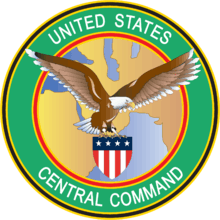 |
United States Central Command | CENTCOM | MacDill Air Force Base, Florida | Egypt through the Persian Gulf region, into Central Asia, excluding Israel | |
 |
United States European Command | EUCOM | Stuttgart, Germany | Europe, including Turkey, and Israel | Also Supreme Allied Commander Europe (SACEUR) |
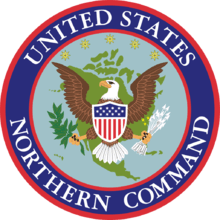 |
United States Northern Command | NORTHCOM | Peterson Air Force Base, Colorado | North American homeland defense and coordinating homeland defense with federal and state civil authorities. | Also Commander of North American Aerospace Defense Command (NORAD) (bilateral U.S.-Canadian military command) |
 |
United States Indo-Pacific Command | INDOPACOM | Camp H. M. Smith, Oahu, Hawaii | The Indo-Asia-Pacific region including Hawaii. | |
 |
United States Southern Command | SOUTHCOM | Miami, Florida | South, Central America and the surrounding waters | |
 | United States Cyber Command | CYBERCOM | Fort George G. Meade, Maryland | Provides cyber operations for the Army, Marine Corps, Navy, and Air Force. | Also Director of the National Security Agency |
 |
U.S. Special Operations Command | SOCOM | MacDill Air Force Base, Florida | Provides special operations for the Army, Marine Corps, Navy, and Air Force. | |
 |
United States Strategic Command | STRATCOM | Offutt Air Force Base, Nebraska | Covers the strategic deterrent force and coordinates the use of space assets. | |
 |
United States Transportation Command | TRANSCOM | Scott Air Force Base, Illinois | Covers global mobility of all military assets for all regional commands. |
| The Geographic Commands |
|---|
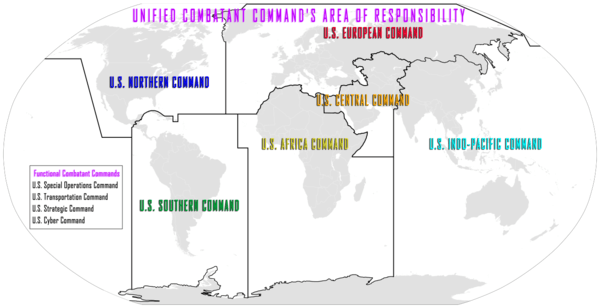 |
In 2007, a new geographical command for Africa was authorized. This proposed significant changes to the areas of responsibility for other adjacent geographical commands as shown in the accompanying graphic.
Office of the Inspector General of the Department of Defense
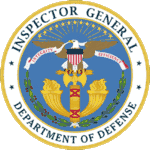
The Office of the Inspector General is an independent and objective unit within the Department of Defense that conducts and supervises audits and investigations relating to the programs and operations of the Department of Defense, pursuant to the responsibilities specified in title 5, U.S.C. Appendix and DoDD 5106.01.
National Guard Bureau
.svg.png)
The National Guard Bureau (NGB) is a joint activity of the Department of Defense. The Chief of the National Guard Bureau is a principal advisor to the Secretary of Defense, through the Chairman of the Joint Chiefs of Staff, on matters involving non-federalized National Guard forces, and other matters as determined by the Secretary of Defense. For NGB matters pertaining to the responsibilities of the Departments of the Army and Air Force in law or DoD policy, the Secretary of Defense normally exercises authority, direction, and control over the NGB through the Secretaries of the Army and the Air Force. The NGB is the focal point at the strategic level for National Guard matters that are not under the authority, direction, and control of the Secretaries of the Army or Air Force, including joint, interagency, and intergovernmental matters where the NGB acts through other DoD officials as specified in DoDD 5105.77.
Other
The United States Naval Observatory falls under the Chief of Naval Operations. In 2003 the National Communications System was moved to the Department of Homeland Security, but only for executive purposes; it still centralizes its activities within the Department of Defense, since the human resources required by NCS (example: Military Departments) still reside within the Department of Defense, or for retention of practical maintenance.
References
- 1 2 "United States Department of Defense Fiscal Year 2016 Budget Request / Overview" (PDF). Office of the Under Secretary of Defense (Comptroller) Chief Financial Officer. February 2015. Retrieved 22 December 2016.
- ↑ "Caselaw: constitution article 2". Retrieved 15 April 2010.
- ↑ 10 U.S.C. 113
- ↑ 10 U.S.C. §§ 3013, 5013 & 8013
- ↑ James 1985, pp. 584–589.
- ↑ James, D. Clayton (1985). Volume 3, Triumph and Disaster 1945–1964. The Years of MacArthur. Boston: Houghton Mifflin. pp. 607–608. ISBN 0-395-36004-8. OCLC 36211311.
- ↑ "DoD Directive 1344.10, February 19, 2008 -- POSTED 2/21/2008" (PDF). Retrieved 2010-10-15.
- ↑ ssenberg, Sasha (28 September 2007). "Army personnel spoke at McCain rally". Boston Globe. Retrieved 15 April 2010.
- ↑ Kumar, Anita (27 January 2010). "McDonnell's guests at tonight's State of the Union response". Washington Post. Retrieved 10 April 2010.
- ↑ "Bob McDonnell's Republican Response to the SOTU: A Military Misstep". 28 January 2010. Retrieved 10 April 2010.
- ↑ "Organizational Chart". U.S. Department of Defense. Retrieved 11 September 2014.
- ↑ http://www.health.mil/aboutMHS.aspx
- ↑ tricare.mil
https://en.wikipedia.org/wiki/Commandant_of_the_Marine_Corps
Further reading
| Wikimedia Commons has media related to United States Department of Defense. |
- Vego, Milan (1999). "Command and Control". In Chambers, John W. & Anderson, Fred. The Oxford companion to American military history. Oxford University Press. pp. 165–167. ISBN 978-0-19-507198-6.

_Official_Seal.png)




